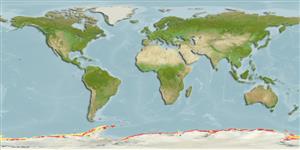Environment: milieu / climate zone / depth range / distribution range
Ecología
marino demersal; rango de profundidad 70 - 550 m. Polar; 60°S - 78°S
Southern Ocean: South Orkney and South Shetland Islands, tip of Antarctic Peninsula north of 65°S and the Antarctic continental shelf.
Length at first maturity / Tamaño / Peso / Age
Maturity: Lm 10.0 range ? - ? cm
Max length : 15.5 cm TL macho / no sexado; (Ref. 124149); 15.3 cm TL (female); peso máximo publicado: 17.00 g (Ref. 124149); peso máximo publicado: 17.00 g
Adults spawn apparently during autumn and early winter. Hatching probably occurs in spring and size at hatching at about 12 mm TL. Main food items are polychaetes and benthic crustacean (Ref. 5192). Larval pelagic phase is short (Ref. 41551).
Gon, O., 1990. Bathydraconidae. p. 364-380. In O. Gon and P.C. Heemstra (eds.) Fishes of the Southern Ocean. J.L.B. Smith Institute of Ichthyology, Grahamstown, South Africa. 462 p. (Ref. 5192)
IUCN Red List Status (Ref. 130435)
Threat to humans
Harmless
Human uses
Pesquerías: sin interés
Herramientas
Special reports
Download XML
Fuentes de Internet
Estimates based on models
Preferred temperature (Ref.
123201): -1.8 - 0.9, mean -1 °C (based on 273 cells).
Phylogenetic diversity index (Ref.
82804): PD
50 = 1.0000 [Uniqueness, from 0.5 = low to 2.0 = high].
Bayesian length-weight: a=0.00257 (0.00167 - 0.00396), b=3.15 (3.02 - 3.28), in cm total length, based on LWR estimates for this species & (Sub)family-body (Ref.
93245).
Nivel trófico (Ref.
69278): 3.3 ±0.3 se; based on diet studies.
Resiliencia (Ref.
120179): Medio, población duplicada en un tiempo mínimo de 1.4-4.4 años (Assuming Fec < 10,000).
Fishing Vulnerability (Ref.
59153): Low vulnerability (10 of 100).
